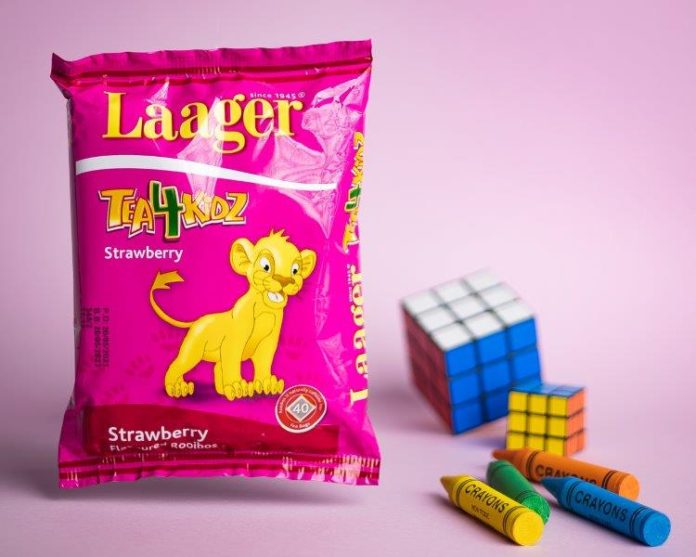With the tumultuous past few months, parents and caregivers with babies are having to contend with the challenges of nurturing youngsters with the additional daily stress of living through a pandemic. Laager Rooibos and partnering dietitian, Mbali Mapholi, seek to make this parenting journey that much easier by sharing useful tips on complementary feeding for babies aged four to six months.
“We understand that parenting can be tough, and the past few months haven’t made this role any easier,” said Wandile Ngubane, Laager Brand Manager. “We’re committed to helping parents and caregivers ensure children get the best possible start, which is why we’ve called on leading South African dietitian, Mbali Mapholi, to share useful insights into providing healthy nutrition for babies when they are introduced to foods.”
One of the trickiest transitions for parents to navigate is complementary feeding. This is when breast milk or baby formula isn’t meeting the sufficient nutritional requirements of infants, and so other foods or liquids need to be included in the diet.
“Young children need enough nutritious food every day to grow healthy, strong, and be able to meet their full development capacity,” explained Mbali. “At around six months old, your baby is growing quickly and needs more energy and nutrients than at any other time in their life.”
Why is it important to add solids to the baby’s diet?
Until around 6 months old, breast milk or formula is sufficient as the sole source of nutrition for babies. And while this will remain the primary source of nutrition until 12 months, the nutritional needs of a baby increase to support growth and development. This is why solids need to be introduced. However, it is important to remember that babies have a small stomach and need soft, nutritious foods in small quantities throughout the day.
What nutrients are important at 6 to 12 months?
· Protein: Babies still get protein from breast milk or formula but their requirements have increased a bit. Some of the food sources for protein include beef, chicken, maas, eggs, legumes, beans and fish.
· Calcium: This is important for the development of bones and teeth, but cow’s milk shouldn’t be given to babies until their first birthday. There are plant-based calcium food sources to add such as green leafy vegetables, tofu, sardines, fortified baby cereal, beans and lentils.
· Whole grains and complex carbohydrates: These are packed with nutrients and proteins that are good for babies. Some food sources include whole-grain bread, whole-grain cereal (baby cereal for spoon-feeding or bite-size cereal for self-feeding), fortified maize-meal, lentils, beans, potatoes and peas.
What is the role of vitamins?
· Vitamin A: This keeps eyes, skin and the immune system healthy and can be found in chicken liver or fish.
· Vitamin C: This supports the immune system; the growth and repair of bones, teeth, gums and tissues; is important for wound healing; and helps with iron absorption. It is found in oranges, spinach, bell peppers, kiwis, tomatoes and potatoes. Laager Tea4Kidz+ is also fortified with Vitamin C, making it the perfect nutrient-enriched hydration.
· B-Vitamins: This helps the body use fat, protein, and carbohydrates to produce energy. These are found in an abundance of fruits and vegetables, legumes and grains, among other foods.
· Vitamin E: This protects the cells from damage, supports immunity and helps the body make red blood cells. It’s found in sunflower oil, margarine, avocados and peanut butter.
· Zinc: For children, zinc is particularly important for growth and immune function. It’s found in eggs, lentils, chicken, oats and brown bread.
· Folate (or Vitamin B9): This keeps the baby’s heart and blood vessels healthy and is found in spinach, certain fruits, beans, meat, eggs, grains and seafood.
· Iron: Bottle-fed babies get their full share of iron from fortified formula, but breastfed babies need another source. This could be meat, egg yolks, wheat germ, whole grain breads, fortified cereals, cooked dried peas and other legumes.
· Omega-3 fatty acids: These are vital for the infant’s growth, vision, and optimal brain development (which is why they’re known as brain food!). These fabulous fats are served up naturally in breast milk, but also are used to enrich some formulas and baby foods. Other food sources include fatty fish, meat, tofu, flaxseed and canola oil.
*Fluids: Once the baby starts on solid foods, small amounts of fluid will start to come from other sources like water or caffeine-free, sugar-free beverages like Laager Tea4Kidz. This range of Rooibos tea is specifically designed for kids, and comes with all the associated benefits of Rooibos such as antioxidants, allergy alleviation, enhanced sleep and improved gut health.
Tips for starting complementary feeding
1. Start slowly as babies have exceedingly small tummies. Your baby can eat anything except honey and cow’s milk, which they should only eat after their first birthday.
2. As the baby’s intake of solids increases, milk intake should remain the same.
3. Offer water or Laager Tea4Kidz in a cup, not a bottle. Avoid fruit and vegetable juices as these may cause dental issues.
4. Do not add sugar, salt, or any seasoning on baby food and beverages. You can add oils, nut butter, margarine or peanut butter to your baby’s foods and drinks to improve their nutrition.
5. At 6 to 8 months, it is suggested to puree or thoroughly mash home-cooked food items.
6. From 9 to 12 months, they can start to eat more textured food items. This is when they can hold and eat chopped up foods.
7. Each meal needs to be both easy for your baby to eat and packed with nutrition. Make every bite count.
8. Cooking your own baby meals at home is the best way to go about meeting their nutritional needs on a budget.
9. If your baby refuses a new food or spits it out, do not force it. Try again a few days later. You can also try mixing it with another food that your baby likes.
Through the More4Momz (www.more4momz.com) website, Laager Tea4Kidz share other useful parenting tips and delicious recipes to keep children interested in healthy food options. For more helpful dietary information, follow @Urbandietitian. For more information on Laager Rooibos or Laager Tea4Kidz, visit @LaagerRooibosTea on Facebook or Instagram, or www.joekels.co.za.












